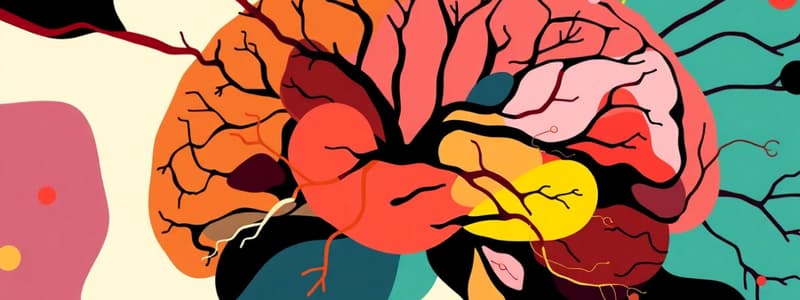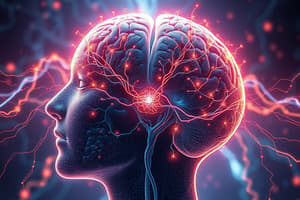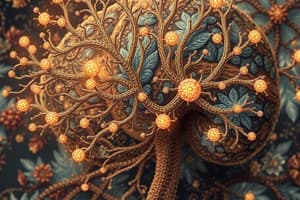Podcast
Questions and Answers
What is the primary role of autonomic functions within the nervous system?
What is the primary role of autonomic functions within the nervous system?
- Facilitating cognitive tasks like planning and thinking
- Controlling voluntary muscle movements
- Regulating sensory perception and movement
- Managing involuntary processes such as heartbeat and digestion (correct)
Which type of neurone is commonly involved in transmitting sensory information?
Which type of neurone is commonly involved in transmitting sensory information?
- Bipolar neurones
- Pseudo-unipolar neurones (correct)
- Anaxomic neurones
- Multipolar neurones
Which part of the nervous system predominantly supports cognitive skills such as thinking and planning?
Which part of the nervous system predominantly supports cognitive skills such as thinking and planning?
- Somatic nervous system
- Central nervous system (correct)
- Autonomic nervous system
- Peripheral nervous system
What is a characteristic feature of the structure of glial cells?
What is a characteristic feature of the structure of glial cells?
What does the term 'mixed spinal nerves' refer to?
What does the term 'mixed spinal nerves' refer to?
What primarily generates the resting membrane potential in neurons?
What primarily generates the resting membrane potential in neurons?
Which ion is found in higher concentration inside the neuron at rest?
Which ion is found in higher concentration inside the neuron at rest?
What is the typical value of the resting membrane potential in neurons?
What is the typical value of the resting membrane potential in neurons?
What role do microglia play in the nervous system?
What role do microglia play in the nervous system?
What effect does the distribution of chloride ions have on resting membrane potential?
What effect does the distribution of chloride ions have on resting membrane potential?
What is the primary role of oligodendrocytes in the central nervous system?
What is the primary role of oligodendrocytes in the central nervous system?
Which type of neuron is primarily responsible for sensory input?
Which type of neuron is primarily responsible for sensory input?
What is the function of astrocytes in the nervous system?
What is the function of astrocytes in the nervous system?
Which glial cell is associated with the peripheral nervous system?
Which glial cell is associated with the peripheral nervous system?
Which function does not belong to microglia in the nervous system?
Which function does not belong to microglia in the nervous system?
What type of neuron does a mitral cell belong to?
What type of neuron does a mitral cell belong to?
Which cell type is primarily involved in scar formation in the nervous system?
Which cell type is primarily involved in scar formation in the nervous system?
Which structure is not directly involved in information processing within the nervous system?
Which structure is not directly involved in information processing within the nervous system?
What is the primary benefit of myelination in axons?
What is the primary benefit of myelination in axons?
Which factor is NOT likely to influence conduction velocity in axons?
Which factor is NOT likely to influence conduction velocity in axons?
What initiates the release of neurotransmitters at the axon terminal?
What initiates the release of neurotransmitters at the axon terminal?
How do postsynaptic potentials (PSPs) influence the generation of new action potentials?
How do postsynaptic potentials (PSPs) influence the generation of new action potentials?
What process describes the summation of postsynaptic potentials from multiple synapses?
What process describes the summation of postsynaptic potentials from multiple synapses?
Which neurotransmitter is NOT mentioned as an example in the content provided?
Which neurotransmitter is NOT mentioned as an example in the content provided?
What happens to neurotransmitters after they diffuse across the synaptic cleft?
What happens to neurotransmitters after they diffuse across the synaptic cleft?
What is the role of calcium ions (Ca2+) at the axon terminal?
What is the role of calcium ions (Ca2+) at the axon terminal?
What is the primary role of the sodium/potassium pump in maintaining the resting membrane potential?
What is the primary role of the sodium/potassium pump in maintaining the resting membrane potential?
Which event occurs first during the generation of an action potential?
Which event occurs first during the generation of an action potential?
What characterizes the action potential as an 'all-or-nothing' response?
What characterizes the action potential as an 'all-or-nothing' response?
What is the primary characteristic of spatial summation?
What is the primary characteristic of spatial summation?
What effect does myelin have on the propagation of action potentials?
What effect does myelin have on the propagation of action potentials?
What is the resting membrane potential primarily characterized by?
What is the resting membrane potential primarily characterized by?
Which term describes the process of successive stimuli affecting one nerve?
Which term describes the process of successive stimuli affecting one nerve?
Which component of the nervous system is primarily responsible for forming the Blood Brain Barrier?
Which component of the nervous system is primarily responsible for forming the Blood Brain Barrier?
At which part of the neuron is an action potential initially generated?
At which part of the neuron is an action potential initially generated?
How does the voltage-gated Na+ channel contribute to action potential propagation?
How does the voltage-gated Na+ channel contribute to action potential propagation?
What role do astrocytes play in the Blood Brain Barrier?
What role do astrocytes play in the Blood Brain Barrier?
What is the significance of depolarization in the context of action potentials?
What is the significance of depolarization in the context of action potentials?
During which phase is the resting membrane potential established?
During which phase is the resting membrane potential established?
Which type of neuron structure includes both dendrites and an axon?
Which type of neuron structure includes both dendrites and an axon?
What is the primary function of neurotransmitters at the synapse?
What is the primary function of neurotransmitters at the synapse?
What is the main purpose of myelin in the nervous system?
What is the main purpose of myelin in the nervous system?
Flashcards
Neurons
Neurons
Specialized cells responsible for transmitting electrical impulses throughout the nervous system.
Soma
Soma
The cell body of a neuron, containing the nucleus and other organelles.
Multipolar Neuron
Multipolar Neuron
A type of neuron with a single axon and multiple dendrites.
Bipolar Neuron
Bipolar Neuron
A type of neuron with a single axon and a single dendrite, often found in sensory systems.
Signup and view all the flashcards
Pseudo-unipolar Neuron
Pseudo-unipolar Neuron
A type of neuron with a single axon that splits into two branches, one acting as a dendrite and the other as an axon.
Signup and view all the flashcards
Microglia
Microglia
A type of glial cell that helps maintain the health of neurons by removing cellular debris and protecting against pathogens.
Signup and view all the flashcards
Ependymal cells
Ependymal cells
These cells line the cavities of the brain and spinal cord, producing cerebrospinal fluid (CSF), which cushions and nourishes the brain.
Signup and view all the flashcards
Resting membrane potential
Resting membrane potential
The difference in electrical charge between the inside and outside of a neuron when it is at rest.
Signup and view all the flashcards
Sodium (Na+)
Sodium (Na+)
A positively charged ion that is more concentrated outside the neuron at rest.
Signup and view all the flashcards
Potassium (K+)
Potassium (K+)
A positively charged ion that is more concentrated inside the neuron at rest.
Signup and view all the flashcards
What do motor neurones do?
What do motor neurones do?
Motor neurones carry signals from the central nervous system (CNS) to muscles and glands, initiating movement and activating bodily functions.
Signup and view all the flashcards
What is the role of sensory neurones?
What is the role of sensory neurones?
Sensory neurones transmit information from sensory receptors (like skin, eyes, ears) to the CNS, providing the brain with data about the environment and the body's state.
Signup and view all the flashcards
What are glial cells?
What are glial cells?
Glial cells are non-neuronal cells that support, nourish, and protect neurons. They do not directly participate in information processing but are crucial for the proper functioning of the nervous system.
Signup and view all the flashcards
What are astrocytes?
What are astrocytes?
Astrocytes are star-shaped glial cells found in the CNS. They regulate the chemical environment surrounding neurons, remove waste, and contribute to brain development.
Signup and view all the flashcards
What are oligodendrocytes?
What are oligodendrocytes?
Oligodendrocytes are glial cells in the CNS responsible for producing myelin, a fatty substance that insulates axons (nerve fibers) and speeds up nerve impulse transmission.
Signup and view all the flashcards
What are Schwann cells?
What are Schwann cells?
Schwann cells, found in the PNS, perform a similar function to oligodendrocytes, creating myelin sheaths around axons and supporting nerve fiber regeneration.
Signup and view all the flashcards
What are microglia?
What are microglia?
Microglia are small, phagocytic glial cells found in the CNS. They act as the immune defense system of the brain, engulfing and destroying pathogens and cellular debris.
Signup and view all the flashcards
What are ependymal cells?
What are ependymal cells?
Ependymal cells are glial cells that line the ventricles (fluid-filled cavities) of the brain and the central canal of the spinal cord. They contribute to cerebrospinal fluid production and circulation.
Signup and view all the flashcards
Depolarization
Depolarization
The process of a neuron becoming more positive, moving its membrane potential closer to zero.
Signup and view all the flashcards
Repolarization
Repolarization
The process of a neuron returning to its resting membrane potential after depolarization.
Signup and view all the flashcards
Action Potential
Action Potential
A rapid and brief reversal of the membrane potential, characterized by a quick depolarization followed by repolarization.
Signup and view all the flashcards
Propagation
Propagation
The process of an action potential traveling along the axon.
Signup and view all the flashcards
Propagation Velocity
Propagation Velocity
The speed at which an action potential travels along the axon.
Signup and view all the flashcards
Myelin
Myelin
A fatty substance that wraps around some axons, increasing the speed of action potential propagation.
Signup and view all the flashcards
Sodium-Potassium Pump
Sodium-Potassium Pump
A pump that actively transports sodium ions out of and potassium ions into the neuron, maintaining the resting membrane potential.
Signup and view all the flashcards
Blood Brain Barrier
Blood Brain Barrier
The selective barrier that controls the passage of molecules between the blood and the nervous tissue.
Signup and view all the flashcards
Threshold
Threshold
The minimum level of stimulation required to trigger an action potential in a neuron.
Signup and view all the flashcards
Hyperpolarization
Hyperpolarization
The process by which the membrane potential of a neuron becomes more negative than its resting potential.
Signup and view all the flashcards
Spatial Summation
Spatial Summation
The addition of simultaneous stimuli from several conducting fibers to trigger an action potential.
Signup and view all the flashcards
Temporal Summation
Temporal Summation
The addition of successive stimuli towards one nerve to trigger an action potential.
Signup and view all the flashcards
Saltatory Conduction
Saltatory Conduction
The process of nerve impulse transmission along myelinated axons, where the action potential 'jumps' from one node of Ranvier to the next.
Signup and view all the flashcards
Synapses
Synapses
Specialized junctions where nerve impulses are transmitted from one neuron to another or to a target cell.
Signup and view all the flashcards
Neurotransmitters
Neurotransmitters
Chemical messengers that transmit signals across synapses.
Signup and view all the flashcards
Summation
Summation
The phenomenon where multiple synaptic inputs combine to influence the postsynaptic neuron.
Signup and view all the flashcards
Postsynaptic Potential (PSP)
Postsynaptic Potential (PSP)
The change in membrane potential of a postsynaptic neuron caused by a neurotransmitter.
Signup and view all the flashcards
Neurotransmitter Reuptake
Neurotransmitter Reuptake
The process of removing neurotransmitters from the synaptic cleft after they have been released.
Signup and view all the flashcards
Action Potential (AP)
Action Potential (AP)
The electrical signal that travels along the axon of a neuron.
Signup and view all the flashcardsStudy Notes
Nervous Tissue 1
- Nervous tissue is responsible for functions like heartbeat, breathing, digestion, body temperature, planning, thinking, emotions and behaviours, sensation, and movement
- Nervous tissue comprises nerve conduction, structure of nervous tissue, and glial cells, and neuron structure.
Neuronal Structure
- A neuron is the functional unit of the nervous system.
- Neurons are specialized cells designed to transmit electrical impulses.
- Neurons share common structural features for sending and receiving information.
- Parts of a neuron: Nucleus, Cell body (Soma), Dendrite, Axon, Axon Terminals.
Neurone Types
- Multipolar: e.g., motor neurons
- Pseudo-unipolar: e.g., sensory neurons
- Bipolar: e.g., in retina or olfactory system
- Anaxonic: with no distinct axon
Neurones Form & Function
- Various examples of neuron types, including motor neurons (spinal cord), Purkinje cells (cerebellum), mitral cells (olfactory bulb) and pyramidal cells (cortex), are shown.
- Their shapes and roles are described
Glial Cells
- Glial cells are not directly involved with information processing but are essential for survival and function of the nervous system.
- Greek for "glue"
- Types of Glial Cells: CNS - Astrocyte, Oligodendrocyte, Microglia, Ependymal cell. PNS - Satellite cell, Schwann cell
Glial Cells Structure & Function
- Diagram displays structure, location and function of these cells
- Extracellular space, blood capillaries and cells (oligodendrocyte, astrocyte, ependymal cell, neuron, microglia)
Cells of the Nervous System Summary
- Neurones: Electrical signaling
- Astrocyte: Regulates extracellular microclimate, removing waste products, helps to control passage between blood & nervous tissue, scar formation
- Oligodendrocyte: Myelination - insulation for the axon & preventing degradation, enhances conduction speed
- Microglia: Immune response, phagocytosis
- Ependymal cell: Producing Cerebral Spinal Fluid (CSF)
- Satellite Cell: PNS support cells, similar to astrocytes in CNS
- Schwann Cell: Myelination - insulation for axon & preventing degradation, enhances conduction speed
Neurones At Rest
- At rest, the inside of the cell membrane has a negative charge (-70mV).
- This is due to an unequal distribution of sodium (Na+), potassium (K+) and chloride (Cl-) ions.
- Extracellular fluid has a net positive charge and intracellular cytoplasm has a net negative charge.
- A membrane potential of minus 70mV
Generation of an Action Potential
- A stimulus creates an influx of positively charged ions, changing the membrane voltage to positive (approximately +30/40mV) - depolarization.
- Rapid influx of Na+ ions followed by efflux of K+ ions forms the action potential.
- All or nothing principle: action potential either occurs or does not, and voltage is always the same magnitude.
Propagation
- Action potential is initiated at the axon hillock and propagates along the axon.
- Voltage-gated Na+ channels cause a regenerative current, maintaining action potential amplitude.
Propagation Velocity
- Action potential speed varies between neurons (0.1 m/s to 100 m/s)
- Myelin increases resistance of the membrane, preventing ion leakage.
- Saltatory conduction is faster in myelinated axons, with action potentials jumping between Nodes of Ranvier.
- Axon diameter and temperature also influence conduction velocity.
Synaptic Transmission
- Action potential reaches axon terminal, calcium channels open, neurotransmitters released into the synaptic cleft
- Neurotransmitter diffuses across cleft and binds to receptors on postsynaptic neuron.
- Activation of receptors opens Na+ channels, causing a postsynaptic potential.
- If threshold reached, AP generated in postsynaptic neuron.
- Neurotransmitters reabsorbed
Summation
- Individual stimuli might be insufficient to trigger an action potential, but their sum can exceed the threshold.
- Spatial summation: simultaneous stimuli from multiple synapses sum together to reach the threshold.
- Temporal Summation: multiple stimuli in rapid succession sum together to reach the threshold.
Blood Brain Barrier
- The BBB is a protective barrier between the blood and the brain.
- Epithelial cells, proteins and astrocytes form the BBB, selectively controlling what passes.
Studying That Suits You
Use AI to generate personalized quizzes and flashcards to suit your learning preferences.




